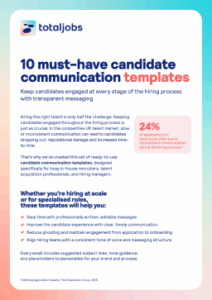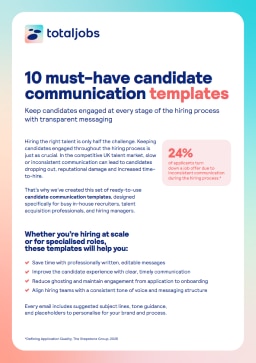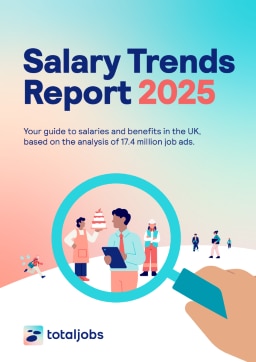
5 recruitment challenges and how to overcome them in 2025
Table of Contents
- Talent quality and shortages
- Long hiring processes
- Budget constraints
- Generational differences in hiring
- Retaining top talent post-hire
- FAQs

Candidate Communication Templates
To build a successful talent acquisition strategy, hiring teams need to understand the obstacles they face and know how to overcome them.
In this article, we’ll explore key recruitment challenges and provide actionable solutions to help you secure the talent you need this year.
1. Talent shortages and attracting high-quality candidates
One of the most pressing recruitment challenges employers are currently facing is a shortage of talent, a situation exacerbated by a labour market demanding specialised skills.
67%
of recruiters struggle to find candidates with the skills they need
Our research suggests that 2 in 3 recruiters find it difficult to identify candidates with the appropriate skill sets, underscoring the shifting dynamics of the hiring landscape, where jobseekers are often expected to possess specific qualifications that are increasingly hard to come by.
In addition, 53% of employers report difficulties in identifying suitable candidates for the roles they are trying to fill. This disconnect seems to primarily arise from a growing skills gap between what candidates offer and what employers require. As industries adapt to rapid technological advancements, the necessity for specific expertise often exceeds the pool of qualified candidates available.
How to overcome it
To address these shortages, employers can work to expand their talent pools and refine their approaches.
First, the rise of remote work has fundamentally transformed recruitment practices. Organisations can now tap into wider talent markets by implementing flexible work policies, enabling them to attract candidates outside of their own geographical location. This not only increases the pool of potential candidates but also offers access to individuals with specialised skills that may be unavailable locally.
Investing in employees through upskilling and reskilling programmes is another effective strategy. By enhancing the capabilities of existing staff members, organisations can bridge skills gaps while simultaneously fostering a culture of continuous learning and development.
Employers can also leverage AI-driven recruitment tools to improve their hiring processes. By focusing on skills-based matching rather than traditional job titles, AI can help mitigate conscious and unconscious biases and promote diverse candidates who may not fit conventional profiles.
2. Long hiring processes and candidate drop-off
Lengthy hiring processes represent another significant challenge, often leading to candidate drop-off. Our research reveals that:
- 49% of candidates abandon their applications due to unclear job details
- 45% of jobseekers cite lengthy application forms as a deterrent
Moreover, the frustration caused by a lack of feedback leads 35% of candidates to withdraw their applications, and 33% express dissatisfaction with excessive document uploads. These issues highlight the urgent need for enhanced efficiency and clarity in recruitment practices.
Today’s candidates also expect streamlined application processes and timely communication regarding their applications. They spend an average of 42 minutes completing applications and 72% expect feedback within a week.
How to overcome it
To mitigate candidate drop-off, organisations can focus on simplifying application processes and providing a positive candidate experience.
Reviewing application forms to eliminate unnecessary fields can significantly enhance the user experience, thereby reducing abandonment rates. Allowing candidates to upload their CVs instead of filling out extensive forms is another effective measure, as research shows that 41% of candidates prefer this method.
Improving communication throughout the hiring journey can also bolster candidate engagement. Implementing automated systems to provide timely updates ensures candidates feel valued and informed at every stage of the process.
The integration of AI and chatbots can further enhance efficiency in recruitment. AI-driven tools can pre-screen candidates based on qualifications and experiences, allowing hiring managers to focus on the most suitable individuals.
3. Salary expectations vs budget constraints
Rising salary expectations pose a critical challenge for many organisations in 2025.
Candidates consistently prioritise salary in their job searches, with our research indicating that 72% of candidates view salary as the most important aspect of a job offer. This situation creates a complex dilemma for employers, particularly those grappling with strict budget constraints.
Small to medium-sized enterprises often find it especially difficult to compete with larger organisations that have more financial resources. This widening gap between candidates’ salary expectations and what employers can feasibly offer represents an ongoing hurdle in the recruitment landscape.
How to overcome it
To attract top talent in light of budgetary limitations, employers should consider offering non-monetary benefits that align with candidates’ preferences.
We found that 66% of employees would willingly forgo a salary increase for their most desired benefit. So, by prioritising what candidates value most, employers can design attractive compensation packages that cater to their needs.
For UK workers, the most popular perks revolve around:
- Work-life balance (49%)
- Flexible working hours (37%)
- Job security (37%)
- Convenient locations (35%)
- Positive work culture (27%)
Additionally, emphasising career growth opportunities can mitigate the challenge of salary discussions. Candidates often view professional development as a significant factor in their decision-making processes. Promoting training programmes, mentorship opportunities, and clear pathways for advancement can encourage candidates to see roles as long-term investments in their future.
4. Adapting to generational differences in hiring
Recruiters and employers are encountering challenges when looking to attract and engage a workforce spanning various generations, with age-related biases creating barriers for both younger and older candidates.
For instance, 37% of job seekers over 50 may avoid positions that appear to target younger audiences, while 1 in 3 candidates (33%) worry that their age will negatively impact their job prospects.
In contrast, younger candidates also face unique challenges. Our research indicates that Gen Z applicants submit an average of 24 job applications before securing a position, double the number submitted by Gen X (12) and Baby Boomers (11). This high volume illustrates the intense competition for early-career opportunities within the job market.
How to overcome it
To foster inclusivity in their recruitment strategies, employers can focus on crafting job advertisements that appeal to a wide range of candidates.
Avoiding exclusionary terms that may alienate older applicants is essential. Phrases like “digital native” or “high-energy team” could deter experienced professionals from considering opportunities. Instead, using balanced language that highlights reliability alongside innovation will attract candidates from different age groups.
Employers should also aim to assemble age-diverse hiring panels, as research shows that 80% of candidates believe these panels can reduce bias in the recruitment process. Creating teams that reflect a mix of ages can enhance trust in the hiring process and offer broader perspectives during candidate evaluations.
5. Retaining top talent post-hire
High employee turnover rates represent a significant challenge for employers in 2025.
1 in 3 UK workers plan to look for new employment this year, and this rate of turnover intensifies the need for organisations to identify and address the root causes of employee dissatisfaction.
Common reasons cited for leaving include:
- A lack of career growth opportunities
- Poor management practices
- Inadequate benefits
Addressing these concerns is crucial for cultivating a workplace where employees feel valued, engaged, and supported.
How to overcome it
A structured onboarding process plays an essential role in retaining new employees.
Comprehensive onboarding programmes can help to foster engagement from day one, including things like:
- Comprehensive training
- Introductions to key team members
- Insights into the organisational culture
In addition to this, pairing new hires with more experienced mentors can provide invaluable support during their integration. Doing so can facilitate a sense of belonging and community across the workforce.
Finally, investing in career development is equally important for enhancing retention rates. Many workers seek employers committed to their professional growth, which can lead to increased satisfaction and loyalty.
Frequently asked questions (FAQs)
What are the main hiring obstacles organisations face today?
Employers often battle issues like talent shortages, lengthy hiring procedures, tight budgets, generational gaps in the candidate pool, and keeping newly recruited staff engaged and committed.
Why is finding quality candidates so difficult right now?
There’s a widening skills gap, with many jobseekers lacking the specialised abilities in demand, especially in industries evolving rapidly due to new technology.
How can hiring teams broaden their candidate pool without sacrificing quality?
Strategies include opening up to remote working, investing in training existing staff, and using skills-based matching rather than relying solely on traditional titles and CVs.
What problems arise from a slow and complex hiring journey?
Lengthy application forms, unclear role expectations, and poor communication often drive potential candidates away before interviews even begin.
Receive the latest recruitment resources and
advice to boost your hiring
By providing us with your details you agree to our privacy policy and for us to keep you updated with the latest news, events,
and special offers from Totaljobs.









